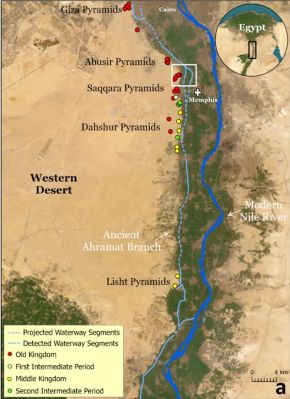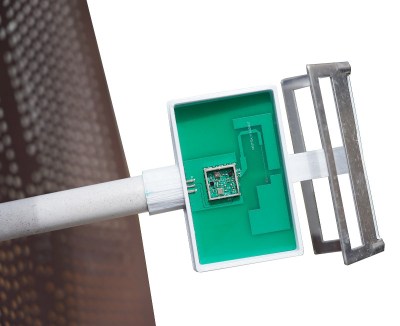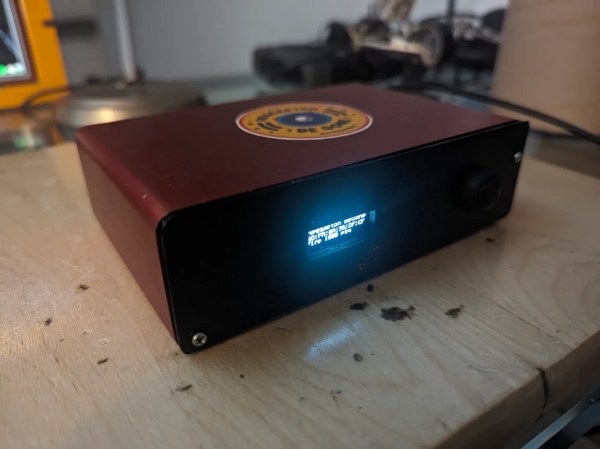 One of the most sought after substances in the Universe is water – especially in its liquid form – as its presence on a planet makes the presence of life (as we know it) significantly more likely. While there are potentially oceans worth of liquid water on e.g. Jupiter’s moon Europa, for now Mars is significantly easier to explore as evidenced by the many probes which we got onto its surface so far. One of these was the InSight probe, which was capable of a unique feat: looking inside the planet’s crust with its seismometer to perform geophysical measurements. These measurements have now led to the fascinating prospect that liquid water may in fact exist on Mars right now, according to a paper published by [Vashan Wright] and colleagues in PNAS (with easy-read BBC coverage). Continue reading “Possible Discovery Of Liquid Water In Mars’ Mid-Crust By The Insight Lander”
One of the most sought after substances in the Universe is water – especially in its liquid form – as its presence on a planet makes the presence of life (as we know it) significantly more likely. While there are potentially oceans worth of liquid water on e.g. Jupiter’s moon Europa, for now Mars is significantly easier to explore as evidenced by the many probes which we got onto its surface so far. One of these was the InSight probe, which was capable of a unique feat: looking inside the planet’s crust with its seismometer to perform geophysical measurements. These measurements have now led to the fascinating prospect that liquid water may in fact exist on Mars right now, according to a paper published by [Vashan Wright] and colleagues in PNAS (with easy-read BBC coverage). Continue reading “Possible Discovery Of Liquid Water In Mars’ Mid-Crust By The Insight Lander”
Cisco Ball Is The Tumbleweed Opposite Of A Disco Ball
Inspiration can strike a maker at any moment. For [Laura Kampf], it happened in the desert when she saw a tumbleweed.
Tumbleweeds roll through the western United States, hitting cars on the interstate and providing some background motion for westerns. [Kampf] found the plant’s intricate, prickly structure mesmerizing, and decided to turn it into a piece of contemplative kinetic art.
[Kampf] attached the tumbleweed to a piece of wood using epoxy and mounted it to what appears to be a worm drive motor nestled inside an interestingly-shaped piece of wood. As the tumbleweed turns, a light shines through it to project a changing shadow on the wall to “create silence, it creates calmness, it takes away from the noise that surrounds it.” While [Kampf] has some work to do to get the sculpture to its finished state, we can get behind her mantra, “The most important thing about the phase of execution is to get started.”
Are you looking for some projects of your own to help you find calm? How about some ambient lighting, a sand drawing table, or a music player that keeps things simple?
Continue reading “Cisco Ball Is The Tumbleweed Opposite Of A Disco Ball”
Root Your Sleep Number Smart Bed, Discover It Phoning Home
Did you know you can get a “smart bed” that tracks your sleep, breathing, heart rate, and even regulates the temperature of the mattress? No? Well, you can get root access to one, too, as [Dillan] shows, and if you’re lucky, find a phone-home backdoor-like connection. The backstory to this hack is pretty interesting, too!
You see, a Sleep Number bed requires a network connection for its smart features, with no local option offered. Not to worry — [Dillan] wrote a Homebridge plugin that’d talk the cloud API, so you could at least meaningfully work with the bed data. However, the plugin got popular, Sleep Number didn’t expect the API to be that popular. When they discovered the plugin, they asked that it be shut down. Tech-inclined customers are not to be discouraged, of course.
Continue reading “Root Your Sleep Number Smart Bed, Discover It Phoning Home”
Rediscovering The Nile: The Ancient River That Was Once Overlooked By The Egyptian Pyramids
Although we usually imagine the conditions in Ancient Egypt to be much like the Egypt of today, back during the Holocene there was significantly more rain as a result of the African Humid Period (AHP). This translated in the river Nile stretching far beyond its current range, with many more branches. This knowledge led a team of researchers to test the hypothesis that the largest cluster of pyramids in the Nile Valley was sited along one of these now long since vanished branches. Their findings are described in an article published in Communications Earth & Environment, by [Eman Ghoneim] and colleagues.

The CliffsNotes version can be found in the accompanying press release by the University of North Carolina Wilmington. Effectively, the researchers postulated that a branch of the Nile existed along these grouping of pyramids, with their accompanying temples originally positioned alongside this branch. The trick was to prove that a river branch once existed in that area many thousands of years ago.
What complicates this is that the main course of the Nile has shifted over the centuries, and anthropogenic activity has obscured much what remained, making life for researchers exceedingly difficult. Ultimately a combination of soil core samples, geophysical evidence, and remote sensing (e.g. satellite imagery) helped to cement the evidence for the existence what they termed the Ahramat Nile Branch, with ‘ahramat’ meaning ‘pyramids’ in Arabic.
Synthetic Aperture Radar (SAR) and high-resolution radar elevation data provided evidence for the Nile once having traveled right past this string of pyramids, also identifying the modern Bahr el-Libeini canal as one of the last remnants of the Ahramat Branch before the river’s course across the floodplain shifted towards the East, probably due to tectonic activity. Further research using Ground Penetrating Radar (GPR) and Electromagnetic Tomography (EMT) along a 1.2 km section of the suspected former riverbed gave clear indications of a well-preserved river channel, with the expected silt and sediments.
Soil cores to a depth of 20 and 13 meters further confirmed this, showing not only the sediment, but also freshwater mussel shells at 6 meter depth. Shallow groundwater was indicated at these core sites, meaning that even today subsurface water still flows through this part of the floodplain.
These findings not only align with the string of pyramids and their causeways that would have provided direct access to the water’s edge, but also provided hints for a further discovery regarding the Bent Pyramid — as it’s commonly known — which is located deep inside the desert today. Although located far from the floodplain by about a kilometer, its approximately 700 meters long causeway terminates at what would have been a now extinct channel: the Dahshur Inlet, which might also have served the Red Pyramid and others, although evidence for this is shakier.
Altogether, these findings further illustrate an Ancient Egypt where the Old Kingdom was followed by a period of severe changes, with increasing drought caused by the end of the AHP, an eastwardly migrating floodplain and decreased flow in the Nile from its tributaries. By the time that European explorers laid eyes on the ancient wonders of the Ancient Egyptian pyramids, the civilization that had birthed them was no more, nor was the green and relatively lush environment that had once surrounded it.
RGB LED Disco Ball Reacts To Sound And Color
Although disco music and dancing may be long dead, the disco ball lives on as a staple of dance parties everywhere. [Tim van de Vathorst] spent a considerable amount of time reinventing the disco ball into something covered with RGB LEDs that reacts to sound and uses a color sensor to change hue based on whatever it’s presented with.
 [Tim] started by modeling the disco ball after a soccer ball with a mixture of pentagons and hexagons. Then it was off to the laser cutter to cut it out of 3mm plywood sheets. Once assembled, [Tim] added LED strips across all the faces and wired them up. Then it was time to figure out how to hold the guts together inside of the ball. Back to the drawing board and laser cutter [Tim] went to design a simple two-piece skeleton to hold the Raspberry Pi and the power supply.
[Tim] started by modeling the disco ball after a soccer ball with a mixture of pentagons and hexagons. Then it was off to the laser cutter to cut it out of 3mm plywood sheets. Once assembled, [Tim] added LED strips across all the faces and wired them up. Then it was time to figure out how to hold the guts together inside of the ball. Back to the drawing board and laser cutter [Tim] went to design a simple two-piece skeleton to hold the Raspberry Pi and the power supply.
In order to do some of the really interesting effects, [Tim] had to make sure that the faces were divvied up correctly in code. That was difficult and involved a really big array, but the result looks worth the trouble. Finally, [Tim] covered the ball in white acrylic to diffuse the LEDs. As you will see in the build/demo video after the break, the ball turned out really well. The only real problem is that the camera doesn’t work very well without light, which is something good parties are usually short on. [Tim] might add a spotlight or something in the future.
Do you prefer the mirrored look of the standard disco ball? Peep the tiny one in this Disco Containment Unit.
Continue reading “RGB LED Disco Ball Reacts To Sound And Color”
Reggaeton-Be-Gone Disconnects Obnoxious Bluetooth Speakers
If you’re currently living outside of a Spanish-speaking country, it’s possible you’ve only heard of the music genre Reggaeton in passing, if at all. In places with large Spanish populations, though, it would be more surprising if you hadn’t heard it. It’s so popular especially in the Carribean and Latin America that it’s gotten on the nerves of some, most notably [Roni] whose neighbor might not do anything else but listen to this style of music, which can be heard through the walls. To solve the problem [Roni] is now introducing the Reggaeton-Be-Gone. (Google Translate from Spanish)
Inspired by the TV-B-Gone devices which purported to be able to turn off annoying TVs in bars, restaurants, and other places, this device can listen to music being played in the surrounding area and identify whether or not it is hearing Reggaeton. It does this using machine learning, taking samples of the audio it hears and making decisions based on a trained model. When the software, running on a Raspberry Pi, makes a positive identification of one of these songs, it looks for Bluetooth devices in the area and attempts to communicate with them in a number of ways, hopefully rapidly enough to disrupt their intended connections.
In testing with [Roni]’s neighbor, the device seems to show promise although it doesn’t completely disconnect the speaker from its host, instead only interfering with it enough for the neighbor to change locations. Clearly it merits further testing, and possibly other models trained for people who use Bluetooth speakers when skiing, hiking, or working out. Eventually the code will be posted to this GitHub page, but until then it’s not the only way to interfere with your neighbor’s annoying stereo.
Thanks to [BaldPower] and [Alfredo] for the tips!
Discovery Dish Lets You Pick Up The Final Frontier
These days, affordable software defined radios (SDRs) have made huge swaths of the spectrum available to hobbyists. Whether you’re looking to sniff the data from that 433 MHz thermometer you’ve got in the backyard or pick up transmissions from satellites, the same little USB-connected box can make it happen.
But even the best SDR is constrained by the antenna it’s connected to, and that’s where it can still get a little tricky for new players. Luckily, there’s a new option for those who want to pick up signals from space without breaking the bank: the Discovery Dish by KrakenRF. After reaching 105% of its funding goal on December 20th, the handy little 65-cm aluminum reflector looks like it’s on track to ship out this summer.
 The Discovery Dish was designed from the ground up to enable hobbyists to receive real-time weather data from satellites transmitting in the L band (GOES, NOAA, Meteor, etc.) and experiment with hydrogen line radio astronomy. Neither of which are anything new, of course. But having a pre-built dish and feed takes a lot of the hassle out of picking up these distant signals.
The Discovery Dish was designed from the ground up to enable hobbyists to receive real-time weather data from satellites transmitting in the L band (GOES, NOAA, Meteor, etc.) and experiment with hydrogen line radio astronomy. Neither of which are anything new, of course. But having a pre-built dish and feed takes a lot of the hassle out of picking up these distant signals.
Although the current prototype has a one-piece reflector, the final Discovery Dish will break down into three “petals” to make storage and transport easier. If you don’t want to take it all the way apart, you can simply remove the feed to make it a bit more compact. Speaking of which, KrakenRF is also offering three different feeds depending on what signals you’re after: L band, Inmarsat, or hydrogen line.
You still have options if you’ve got to keep your radio hacking on a tighter budget. As we saw recently, you can actually pull an ET and pick up weather satellites using a foil-lined umbrella. Or spend a little at the big box hardware store and grab some aluminum flashing.
Continue reading “Discovery Dish Lets You Pick Up The Final Frontier”


















